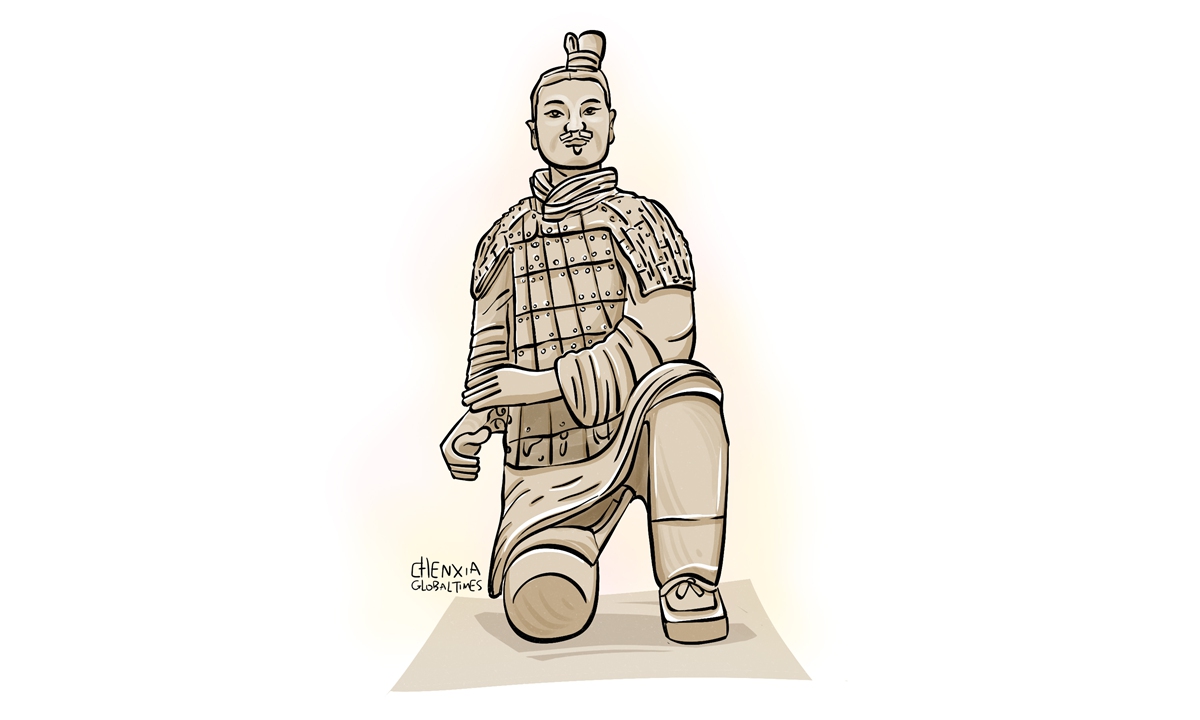
Illustration: Chen Xia
This year marks the 50th anniversary of the discovery of the Terracotta Warriors, one of the greatest archaeological finds of the 20th century. On Sunday, an international conference on protecting the Qinshihuang Mausoleum and its surrounding heritage site was held.
That same day, an exhibition also opened at the Qinshihuang Mausoleum Site Museum in Xi'an, Northwest China's Shaanxi Province, to commemorate the 50th anniversary of the discovery and excavation of the iconic Terracotta Warriors. It is also the first exhibition of its kind to showcase such a broad selection of artifacts - 230 pieces from significant discoveries made over five decades.
In 1974, local farmers accidentally unearthed clay fragments while digging a well, leading to the discovery of the Terracotta Warriors.
Around 2,000 life-size clay warriors and numerous weapons have been unearthed from three pits surrounding the tomb of Emperor Qinshihuang of the Qin Dynasty (221BC-207BC), the first emperor of a unified China. The army of Terracotta Warriors was added to the UNESCO World Heritage List in 1987.
After 50 years of excavation and research, over 10 above-ground building sites and more than 500 underground burial pits and tombs have been discovered in the mausoleum. Over 50,000 relics have been unearthed.
As we reflect on this half-century of excavation and preservation, it's clear that the Terracotta Warriors have evolved into more than just an archaeological marvel - they have become a cultural icon for China and the world. The influence of the Terracotta Warriors goes far beyond their historical and artistic value.
Li Gang, director of the Qinshihuang Mausoleum Site Museum, captured the significance of the Terracotta Warriors perfectly when he described them as a "wonder in the history of world heritage exhibitions" and a "gold business card" for Chinese cultural heritage diplomacy.
"They play an irreplaceable role in enhancing the shared identity of the Chinese nation, promoting cross-cultural exchange, and contributing to global cultural heritage governance. By telling the story of these ancient warriors, they have made a unique contribution to fully, comprehensively, and authentically showcasing both ancient and modern China," said Li.
Over the past 50 years, archaeologists have revealed the complex layout of the mausoleum, centered around the emperor's burial mound and surrounded by inner and outer walls, burial pits, and accompanying tombs.
The artifacts from the site offer a glimpse into the technological, material, and institutional advancements that emerged around unification of China under Qinshihuang.
Opening Sunday, the exhibition showcases 230 relics from significant discoveries made over five decades. The exhibition uses innovative display techniques, such as large-scale models, digital interaction, and live broadcasts, to present the mausoleum's history, design, and cultural value from multiple perspectives.
Notably, the artifacts on display, including those unearthed from the eastern gate of the outer city, the tomb's architectural remains, and accompanying tombs, are being presented to the public for the first time.
According to Ye Ye, deputy head of exhibition department of the Qinshihuang Mausoleum Site Museum, the exhibit follows the design philosophy of the mausoleum, highlighting its grand layout, ceremonial buildings, burial pits, tombs, and unearthed artifacts, vividly portraying the rich political, economic, military, and artistic life of the Qin Dynasty.
The global appeal of the Terracotta Warriors has been evident since their first overseas exhibition in Japan in 1976. Since then, the artifacts from the site have traveled to 49 countries and nearly 200 cities, with 277 exhibitions drawing in more than 20 million visitors, according to media reports. These international tours have played a crucial role in spreading Chinese culture, history, and values across the globe.
Beyond their cultural significance, the Terracotta Warriors have been a key player in promoting international cooperation. The year 2024 also coincides with the 45th anniversary of the establishment of the Qinshihuang Mausoleum Site Museum.
The museum has signed cooperation agreements and memorandums with institutions from countries including Germany, Belgium and the UK, advancing China's principles of heritage protection on the global stage. These collaborations help promote China's conservation methods.
The Terracotta Warriors site not only allows visitors to witness the "Eighth Wonder of the World," but also provides a model and experience for the protection and display of large-scale archaeological heritage in China.
In many ways, the preservation of the Terracotta Warriors symbolizes the broader advancements in China's cultural heritage field. From the painstaking eight-year restoration of the bronze chariots and horses to the use of advanced technology to stabilize fragile artifacts, the outstanding technology and craftsmanship not only demonstrate the dedication of cultural heritage workers but also highlight the pursuit of excellence in China's cultural heritage preservation efforts.




